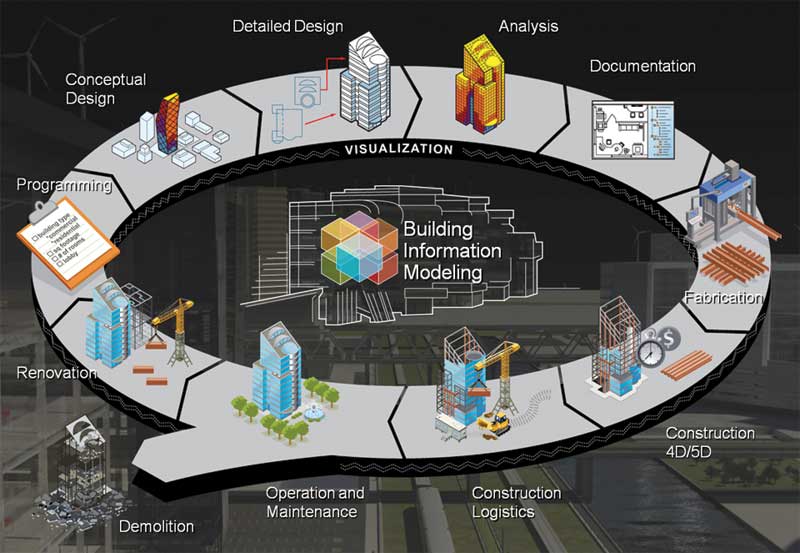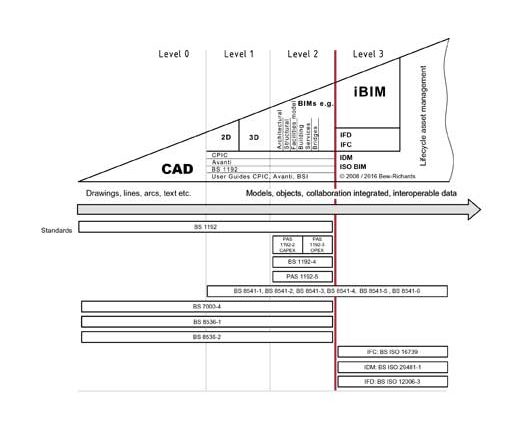BIM in Canada: Moving toward a national mandate for building information modelling

Image courtesy Autodesk
Finally, without a strong mandate, BIM deployment in Canada risks being left to individual companies that develop their own standards and mechanisms; this could result in an ad-hoc, disparate, and fragmented implementation process. The country could end up with various forms of standards and guidelines, hindering the overall implementation process—effort will be wasted on attempting to bridge these different standards and guidelines and fulfil these different mandates, instead of focusing on value-adding activities.
To overcome the current limitations of BIM use in Canada, mitigate the risks associated to an ad-hoc implementation, and, most importantly, provide the Canadian AECOO community with a clear direction for its transition toward a highly efficient and value-generating one, a strong BIM mandate is key. Further, it must happen at the national, provincial/territorial, and municipal levels.
What does a mandate entail?
Existing or emerging mandates from around the world vary widely in scope and intent. They all have at their core, however, requirements relating to BIM and expected outcomes relating to its use on publicly funded projects. The key element is a mandate should be specifying ‘outcomes,’ rather than ‘means and methods.’ This is important since clients typically do not tell their supply chain how to deliver their projects (nor do they want to).
More precisely, a national mandate should be developed that:
- coherently scopes its extent and reach;
- clearly describes the relevant requirements, outcomes,
and deliverables; - references international standards (e.g. ISO 16739:2013, Industry Foundation Classes [IFC] for Data-sharing in
the Construction and Facility Management Industries, or
ISO 29481, Building Information Models: Information Delivery Manual); - references national standards and guidelines (a ‘Canadian National BIM Standard’ would have to be developed, akin to the one in the United States);
- would be scalable in that it would define minimum requirements for various types of projects or levels of implementation required; and
- would be evolutive in that it would take into account current capabilities within the industry and evolve through time as the industry grows more mature (similarly to the United Kingdom’s BIM levels).
For example, a first, basic mandate would call for the provision of a co-ordinated (i.e. zero true-positive clashes to within a certain tolerance), multi-disciplinary, federated model that will contain basic asset information (i.e. model elements developed to specific Levels of Development [LOD]) at tender, and is kept current during construction with manufacturer information, including warranty, for major asset types upon completion of the project. Throughout project delivery, data drops would be specified (to replace the traditional 30, 60, and 90 per cent revision milestones), and clear sets of minimum expected data would be defined at each stage. (Data drops in the context of U.K. projects are discussed at www.bimtaskgroup.org/cobie-data-drops.) The federated model would be delivered using open standards for BIM, namely industry foundation classes (IFCs) and the model view definition (MVD) framework, satisfying the developed national BIM standard. This would become the minimum requirement for all publicly funded projects in Canada (should the mandate be adopted at all tiers of government across the country).
It is important to note this mandate would not dictate how project teams develop or use models throughout a project’s life cycle. Instead, it would establish a common baseline for models in the public realm, which could be automatically audited and validated. One could think of this as the performance-based National Building Code of Canada (NBC) for the project delivery process.
It is also critical to note the national BIM mandate is part of a larger framework supporting the Canadian AECOO community’s transition to more efficient and effective practices, as well as the generation of best value for money on public projects. This framework comprises:
- a national strategy for the Canadian AECOO community that lays out the need for change and establishes the way forward, with BIM as part of the solution (this strategy should be developed and endorsed by all levels of government and public
bodies such as universities and healthcare facilities); - a national BIM mandate that sets the foundation for BIM use across Canada as part of a nation-wide strategy for the Canadian design, construction, and asset management sector; and
- a national BIM standard and guidelines that provides the direction and support for the delivery of BIM in the context of publicly funded projects.

Image courtesy BSI
What are the challenges and risks associated with this strategy and mandate?
The biggest challenge to this strategy is the current capability and awareness gap associated with BIM in Canada. While the mandate aims to close that gap, the strategy will have to lay out a clear plan and provide significant resources to support training and education programs across Canada to help all AECOO stakeholders get up to speed. Another risk is the asymmetrical or inconsistent mandating of BIM by different public bodies across Canada. This is why a national strategy, mandate, and BIM standard are highlighted as being necessary to ensure consistency of the implementation process. Should local or provincial governments start developing mandates and standards in isolation, there is a great risk of causing confusion and undue complexity throughout the project delivery process. Further, inconsistent BIM mandates across the country would exacerbate the capabilities gap.
How do we get there?
In January 2015, buildingSMART Canada published its “Roadmap to Life Cycle BIM in the Canadian AECOO Community.” Issued as a call to action, it lays out a comprehensive plan to guide the Canadian AECOO community in improving its performance and contributing more effectively the country’s societal, environmental, and economic development.
The ‘roadmap’ is founded on six principles:
- All Canadian AECOO community stakeholders, at all levels, must be actively engaged in the sector’s transformation.
- The technologies, processes, and standards supporting the transformation must be developed and maintained in a rigorous, consistent, and continual way.
- All Canadian AECOO community stakeholders must be educated and trained to ensure the transformation be successful and maintained.
- The tools, technology, and processes that are developed must be deployed and adopted within a conducive environment across the Canadian AECOO community.
- The progression of this transformation must be continuously monitored and evaluated for ensuring effectiveness.
- The movement must be sustained by all Canadian AECOO community stakeholders well beyond the initial transformation cycle.
These six principles form the basis for the six streams of the roadmap, which are seen as key in advancing and framing the BIM agenda forward
in Canada.
Over the past two years, buildingSMART Canada has been actively working toward fulfilling the roadmap activities and has garnered considerable support from industry stakeholders. However, it is still some ways off from a comprehensive and conducive environment for the deployment of BIM in Canada. It is time for public bodies to heed this call to action and take the appropriate steps toward a more efficient and effective AECOO community through better project delivery practices enabled through BIM and open standards.
 Erik Poirier, PhD, M.Eng., B.Sc.Arch., LEED AP, chairs the Communications Committee of buildingSMART Canada. He is a postdoctoral fellow at the University of British Columbia’s (UBC’s) building information modelling (BIM) TOPiCS Lab and senior partner at Alta Brevis Partnership. Poirier’s work focuses on enabling collaboration in the AECOO sector through BIM, lean, and integrated approaches. He also specializes in optimizing information life cycles for the built environment. Poirier has co-authored more than a dozen publications in refereed journals and conferences, and has participated in the production of many industry reports and conferences. He can be reached by e-mail at epoirier@ibc-bsc.ca.
Erik Poirier, PhD, M.Eng., B.Sc.Arch., LEED AP, chairs the Communications Committee of buildingSMART Canada. He is a postdoctoral fellow at the University of British Columbia’s (UBC’s) building information modelling (BIM) TOPiCS Lab and senior partner at Alta Brevis Partnership. Poirier’s work focuses on enabling collaboration in the AECOO sector through BIM, lean, and integrated approaches. He also specializes in optimizing information life cycles for the built environment. Poirier has co-authored more than a dozen publications in refereed journals and conferences, and has participated in the production of many industry reports and conferences. He can be reached by e-mail at epoirier@ibc-bsc.ca.







